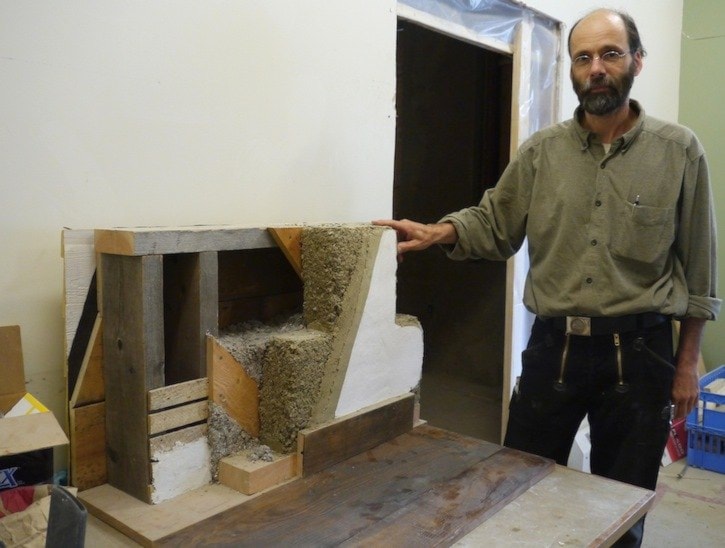Nature drives CPR station design from Bill Metcalfe on Vimeo.
This is part two in a series of three articles about the innovative renovation techniques at the CPR station in Nelson. Part 1 was about the restoration of the heritage windows.
The walls of the renovated CPR station will be made of local and recycled materials and a simple, ancient technology to increase energy efficiency.
The original exterior walls, constructed around 1900, were made of 2x6 studs with wood siding on the outside and with lathe and plaster on the inside, and no insulation.
The new walls will use the old framing, but cellulose insulation made of recycled newspaper will be packed between the studs. Then an inner layer of bricks made of clay and wood waste will be added. On top of that, on the inside finished wall, a layer of plaster and silica-based paint will simulate the look of the original interior.
Materials from local sources
The wood shavings, chips, and sawdust that make up the bricks come from Harrop-Procter Forest Products, as does the 1x4 wood strapping. The clay comes from the Castlegar area.
The 8000 bricks were made at the building site with a low-tech mechanical press — the only one of its kind in North America.
“Nature has driven the design of this exterior envelope and not some flyer from the building supply store,” says Joern Wingender, whose company, Traditional Timber Framing, is the contractor for the restoration of the building.
Wingender says the local materials in the exterior walls mirror the way the original station was built because back then “everything came from the hills around Nelson. The only things imported at that time were lime, glass, and nails.
“You look at what you have got close at hand and that is the driver for your design.”
The building, owned by the Nelson and District Chamber of Commerce, will eventually become the Regional Visitor Gateway, which will house the tourism visitor centre, the Chamber of Commerce, the Nelson Economic Development Partnership, Invest Kootenay and Nelson Kootenay Lake Tourism, as well as other retail and public sector offices and services.

The station will be ready for occupancy in the fall or winter of 2015. All photos by Bill Metcalfe.
New (old) approaches to humidity and temperature
There is no vapour barrier in the new construction.
“We are adding a humidity and temperature buffer with these bricks,” Wingender says. “Because they are wood chip and clay and they have a permeable silica based paint on it, they can absorb moisture, so whenever there is too much moisture in the space the bricks will absorb it and gradually give it off, so there is no chance of condensation.”
As for temperature, Wingender says occupants of the building will be able to keep the temperature two degrees lower than normal but they won’t feel it, because of radiated heat from the bricks.
“We (generate) heat when it is cheap to run the heating system and we can store the heat in the bricks and it radiates back into the space. And if the power goes off and we can’t run heating for an extended period of time, we have this buffer.
“In the summer it works in reverse. The temperature buffer means we would circulate cold night air during the course of the night and then shut the ventilation off in the morning. The bricks were cooled down overnight and it takes them all day to warm up so it is natural air conditioning.”

Joern Wingender points out how the saved original window frames will work with the newly added bricks made of wood chips and clay.
Old school, local, and green
“We have come full circle,” says Wingender. “This is old school, it is centuries-old technology. I visited a house in Pennsylvania that was a timber frame build by Swiss or German immigrants, and it had wood chip clay bricks between the timbers and on the corner was written ‘1773.’
All of the materials and techniques described here are being used on the exterior walls only. The interior walls will be drywalled. The roof slope will be insulated with 13 inches of dense packed cellulose insulation, and the attic with 22 inches.
Hazardous waste removed
Wingender says the chamber has spent $85,000 to remove 13,600 kilograms of hazardous waste, mostly asbestos, from the building.

Joern Wingender and his model of the building envelope.
